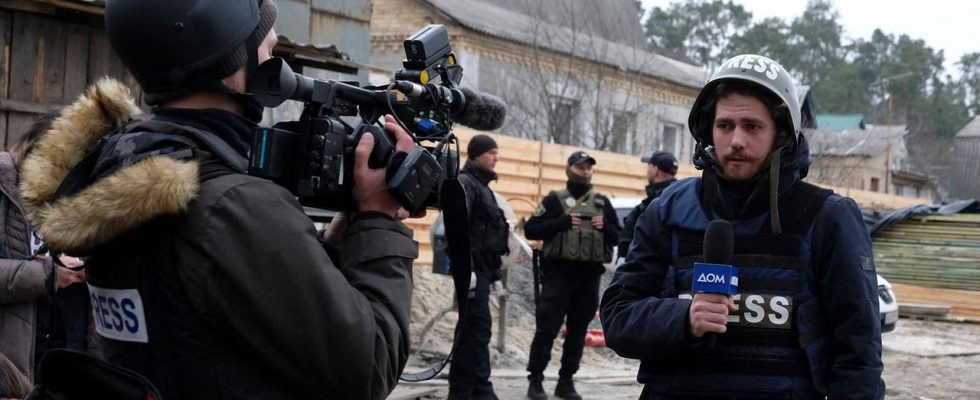Last year, the organization Reporters Without Borders acknowledged Ukraine’s progress in press freedom. But what is the state of the media landscape in the country now?
The news on Ukrainian television is still broadcast on six channels at the same time. Zapping doesn’t help much. After the major Russian invasion on February 24, 2022, the channels linked up – for the so-called telemarathon.
The idea for the “telemarathon” came from the broadcasters themselves. In the chaotic days after the invasion, they decided to join forces and offer people orientation. With enough broadcast space for experts, politicians and military personnel.
Two years later, the “Telemarathon” is still broadcasting. One reason for this is the troubled finances of many broadcasters: a core program simply saves money – and the broadcasters involved also receive subsidies from the state.
“A pretty tight one spectrum of opinions”
However, many Ukrainians are increasingly critical of the program. According to a study by the Kiev International Institute of Sociology, trust in the “telemarathon” has declined sharply: while in May two years ago more than two thirds of those surveyed were of the opinion that the “telemarathon” was a credible source, this was the case in February this year only about a third.
Media expert Oksana Romaniuk would like to see the format ended. Romaniuk is director of the non-governmental organization Institute for Mass Information, which advocates for strong media in Ukraine.
“There’s a pretty narrow range of opinions there. The program consumes a lot of government money. And it has failed to win the public’s trust or capture a significant audience,” says Romaniuk. But the “telemarathon” has had an impact on media usage behavior in Ukraine, she says.
Telegram as Information platform
People in Ukraine want to be constantly informed about events and dangers – as quickly as possible and as close to the source as possible. Therefore, they rely heavily on social networks, especially the messenger service Telegram.
The platform is controversial in Germany because it is often used by all kinds of enemies of democracy. In Ukraine, people there find out about news from the front, the threat of air strikes or the situation in the occupied territories.
Roman Pohorily also has his channel: He is one of the founders of “Deep State Map”, an independent Ukrainian online site that closely analyzes military movements. He has more than 700,000 subscribers on Telegram.
“When we started the project, it was just a map: we thought it would be simple, useful and interesting,” says Pohorily. But today lives depended on their information. “Because many maps are used by evacuation services, including the military and others.”
With “Deep State Map” it is clear who is behind it. But that’s not always the case with Telegram. Many authors remain anonymous. This is understandable in times of war. On the other hand, some authors use these channels to spread disinformation. Telegram is therefore also viewed critically in Ukraine.
Trust in media declined
The organization Reporters Without Borders currently sees Ukraine in 61st place in the global press freedom ranking and speaks of improvements (18 places higher than in 2023). This is mainly due to the lower number of media workers killed by the Russian army.
Last year it gave Ukraine a mediocre rating: out of 180 countries, it placed Ukraine in 79th place. The year before, it was almost 30 places lower.
Overall, trust in the media in Ukraine has declined, says media expert Romaniuk – with the exception of regional and local media. Because the authors there have a name and are trusted because they are there and ask questions.
There are also investigative platforms: “I would say that we have the most developed investigative journalism scene in Eastern Europe,” says Romaniuk. “There is nothing like it. We have very good researchers, very strong independent media and public broadcasters that can be seen across the country.”
Consequences for obstructing journalists
A well-known investigative reporter is Maria Semlanska. She works for the research platform Bihus.info. But Semlanska is also an example of how pressure is still being exerted on journalists in Ukraine.
She and her colleagues were secretly filmed and listened to – and the videos were posted on the Internet. They show, among other things, how some of their team consume cannabis at a private party. A smear campaign to tarnish their reputation. The Ukrainian secret service SBU was apparently behind this.
Semlanska says: “Of course the incident attracted a lot of international attention. Firstly, it was really a major violation of human rights. Secondly, it was an attempt to put pressure on the editorial team.” Nevertheless, such cases repeated themselves again and again. “I can’t say that the whole country has changed after our incident. These are systemic things that need to change over the years.” After the affair became known, a high-ranking SBU employee was fired and the public prosecutor’s office began an investigation.
Journalists are not defenseless
This is also Ukraine: Anyone who persecutes journalists or even hinders them in their work must expect consequences. The spokesperson for the defense forces in the south of the country recently had to leave. Journalists had complained that it was hindering their work.
In fact, it is often difficult to obtain information, says Semlanska. When authorities made inquiries, they often cited the fact that they could not share information for reasons of war. Some colleagues also practiced auto-censorship out of fear that their research would play into the hands of the enemy.
Given the situation, Ukraine is not in a bad position when it comes to press freedom: “We are a young democracy. We don’t have very many independent media outlets. The power apparatus is gradually learning how to deal with the independent press.” The situation is getting better. And after all, it is only psychological pressure – and not physical violence.

